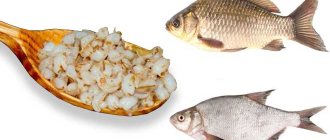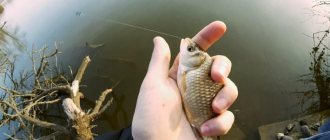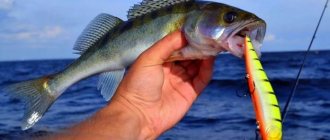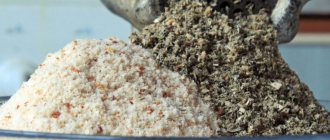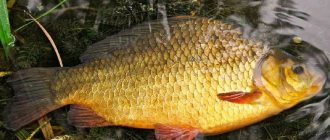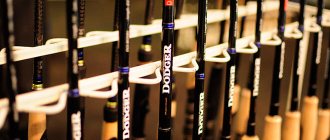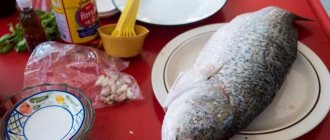On the baked sand
A very interesting and effective bait (bait) is made from calcined sand.
To do this, sand was heated very strongly on a large baking sheet, then sunflower oil (natural, homemade) was added to it, and various natural flavors were added to the sand. They take parsley, mint, dill, hemp, oregano, anise, and so on and so forth.
Sand works for several days.
Catching fish with a button
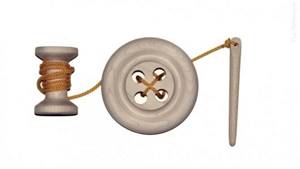
You can use a button to catch bream, silver carp, carp, and carp. A piece of bread crust or cake was tied as bait, and a round or oval button was tied a little higher on another fishing line or thread.
The trick is that the fish, having swallowed the bait, will swallow the button along with it. Since the button is inedible, the fish will spit it out through the gills rather than through the mouth.
Having emerged through the operculum, the button will hold the prey firmly enough in this simple trick. And now all that remains is to pull it ashore and cook the fish soup.
Fish bait
Even people who are far from fishing know what bait is, but most likely they have not even heard about bait and baiting, and they don’t even know how one differs from the other.
With bait, everything is more complicated, because it is designed not to simultaneously attract nearby fish to the desired point, but to develop a conditioned reflex in the fish, like Pavlov’s well-known dog, to swim to feed exactly where it is needed and when it is needed, and in whole flocks. And if you don’t feed the fish, accustomed to a stable diet, on the day of fishing, then it will eat and bite whatever you put on the hook, since hunger is still not a problem, and there is no question of any special suspicion in this case can not. The main thing is to never feed them while fishing.
Privada is not a matter of one day, so it is not accessible to everyone, because most often you can go fishing for one day off, and it is simply impossible to attach the fish to a place during this time. Those who have fishing within so-called walking distance are much luckier, which allows them to have not just one, but two or three baited places at the same time, fishing on which can be done in turn, today - on the first, tomorrow - on the second, in a week - on the third.
The first fishing trip is an indicator of the correct choice of bait, because in different bodies of water or even in different places of one large body of water, preferences can be different. You can experiment with bait by trying one, a friend, a third and choosing the most successful one. The time it takes to acclimate a fish to a place is not the same; for small bodies of water it is shorter, for larger ones it is longer. The time of feeding, that is, casting bait, is usually selected based on the time of the intended fishing, and most often it is either morning or evening.
Read! All about fishing with bread and bread crumbs
The effectiveness of a bait is influenced by a number of factors, such as smell, taste, variety and density. The aroma attracts the desired fish passing by, and sometimes scares away the unwanted ones. The aroma is most effective at night, in muddy or dark, opaque water, because in this case visibility is limited, and the fish largely relies on its sense of smell. The main thing is not to overdo it, because too much flavoring can have the opposite effect and scare away the fish.
The base chosen for bait should ensure that it erodes for as long as possible, because the purpose of baiting is not to feed the fish quickly and to its fullest, but to accustom them to the fact that food can always be found in a given place. Very often, clay is used as a base material, which is usually both available and free. The amount of base (clay) in a plant bait is half of the total weight, in an animal bait it is about a third, its density depends on the current - the faster it is, the thicker the clay; in stagnant water the clay can even be mixed with ground egg shells or sand. How much bait is needed is a delicate matter, and is determined experimentally in a particular place, the main thing is not to give it too much, so that the uneaten does not spoil and does not scare away the fish. There are many recipes for the bait, for example, pour a kilogram of bran with a liter of water, let it brew for about twenty minutes, then rub it through a sieve and leave it to brew for a day or a day. After this, you need to drain the water, add thirty grams of crushed hemp seeds, a couple of drops of anise oil, half a teaspoon of baking soda, and the same amount of fragrant sunflower oil to the resulting mass. Now you need to add flour and knead a stiff dough, form it into balls three to four centimeters in diameter and dry thoroughly, maybe in the oven. The concentrate is ready.
Read! Catchable potato boilies for carp
Most often, the same components that will be used in subsequent fishing are used for bait, but this is not an immutable condition. You can, for example, use thick and tasty maggots for fishing, and attach the fish to the place with cake, all individually, and in the feeding place in the morning a flock of hungry breams and roaches will be eagerly waiting.
Brick as bait for fishing

Porous clay bricks were boiled in a large pot in the courtyard of the house, and various aromatic herbs were added to the water (as with mint, hemp, anise, parsley, oregano, and so on).
As soon as the water boiled away, the herb was added again, water was added and again boiled for a long time, until the brick acquired a persistent smell of aromatic herbs. Then they delivered a hot brick and dipped it in sunflower oil. We used freshly squeezed homemade oil, where there is a smell of seeds.
Upon arrival at the fishing site, this so-called bait was thrown into the water where they were going to fish. The fish gathered near the deliciously smelling, herb-soaked brick, and the fishing rod was cast closer to the place where the brick lay.
What are bite activators made from?
Homemade bite activators are a common solution among fishermen. This is primarily due to lower cost - all the necessary components are cheaper than the factory version. Let's take a closer look at how to make a bite activator at home from available ingredients for various types of fish.
Any activator must include the following components:
- Vegetable oils.
- Ingredients with a pronounced aroma, special flavors.
- Various squeezes.
- Spices.
- Amino acids.
- Ingredients of animal origin are usually selected depending on the type of fish that you plan to catch.
When manufacturing bite activators, it is also necessary to take into account that the features of use will depend on their shape:
- Liquid products should have a strong aroma and are usually intended to be used on artificial tackle or added to the main bait being used. The optimal volume is 5-7% of the total mass.
- Dry or compressed varieties of activators are suitable for throwing into the water at a fishing spot.
All bite activators based on natural ingredients can create a smell that attracts the attention of fish. The flavoring must either be placed in the water separately or added to the base. Fish also have their own taste and aroma preferences, which you need to remember:
- Star anise.
The aroma of anise and the bitter taste attracts non-predatory fish. Interestingly, using anise directly does not give such good results. - Garlic.
It is added to bait both in dried form and as a tincture. Bream and carp like dried garlic, but it is better to add garlic tincture to the bait for crucian carp. - Turmeric.
This seasoning is especially good for catching roach. Experienced fishermen advise not to forget about it during the hot period when catching peaceful fish. - Basil and dill.
This additive will appeal to almost any fish living in muddy waters. - Cinnamon.
A universal bite activator that can be used in any water and at any time of the year. Most often, cinnamon is added to bait for roach and bream. - Thyme.
Indispensable when fishing for cyprinids in flowing waters. - Coriander.
Prepare grain powder before use. This way it will retain its characteristic smell. Suitable for hunting bream in all conditions.
Of course, the list doesn't end there. Cardamom, vanillin, musk, cocoa, honey, cloves, and factory-made baking flavors work well as activators. It is noted that the flavors “strawberry”, “tutti frutti”, “caramel”, “nut”, “creamy” are 100% successful. Find out how to prepare them below.
Fish responds well to oils. In particular, anise, dill, flaxseed and sunflower. From what is available in the pharmacy, camphor alcohol, valerian drops, Zvezdochka balm, and fish oil will be useful. Just add a little bit to your bait and you will see that the number of fish you catch will increase significantly.
Underwater wreath for fishing

In reservoirs where the bottom is pebbly or sandy and without reeds, mud and algae, in the spring, before spawning, pine wreaths are lowered to the bottom. They are made with a diameter of 2-3 meters from pine spruce branches, tied with ropes and a weight is tied so that the wreaths lie at the bottom.
When the fish come to spawn, they will spawn in these “nests” and naturally live here all summer, because their offspring are here and they need to be taken care of. And where there are ordinary fish, there are predators. So you need to catch them in this water area.
Attracting fish to the fishing spot
Photo by the author
How to deliver bait or bait to the intended fishing location? It would seem that there is nothing complicated here. However, experience suggests that there are many subtleties in this matter, which determine the maximum effectiveness of the impact on specific fishing objects. And different methods of supplying food and even distributing it at the bottom of a reservoir have been developed due to differences in fishing conditions.
The easiest delivery method is to throw balls of bait by hand (when fishing in the current and at great depths) or scatter the bait in a fan or path (at shallow depths, at low current speeds, when fishing for high-water fish, etc.) (Fig. 1)
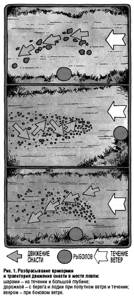
Drawing by the author.
Usually it is difficult to throw bait further than 30 meters by hand - too strong a throw breaks even tightly molded balls in flight. Therefore, for such cases, fishermen use various technical means, sometimes very original. For example, athletes successfully practice special slingshots for long and accurate casting, where the power of the elastic element is selected in accordance with the viscosity of the bait.
Now designs of stationary mini-catapults are beginning to appear, which, unlike a slingshot, are controlled with one hand. On bodies of water without a current, fishermen often use a tailwind from the shore, which helps deliver bait over a very long distance, for example, to the hooks of a donkey-thrower - for this they build “ships” (Fig. 2).
You can make a small platform from dry branches picked up on the shore and install a sail on it from a piece of paper. The platform is loaded with bait and, using any tackle with a reel, sent downwind. When the structure reaches the intended location, they sharply pull the fishing line - the “ship” capsizes, then it is pulled back. The first portion of bait is dropped with a buoy. If you fish with bottom tackle with a rubber shock absorber, there is no need for a sail on the “ship” - the platform is attached to one of the hooks of the donkey, and the rubber band delivers the bait where it is needed.

Drawing by the author.2. “Ship” with bait.3. “Vanka-Vstanka.”4. Beanbag.
Various mesh projectile feeders, which are loaded with well-washed bait and installed in the current at the bottom of the reservoir, have long been known and do not require a detailed description. Often, such feeders are combined with a sliding mount with fishing tackle, so that the hook with the nozzle is always in the “stream” of the feed.
For attaching and feeding upper-water and partly bottom-dwelling fish, the “rattle” (Fig. 3) and the “vanka-stand” (Fig. 4) were invented. The first is a lightweight box or bag with many small holes into which dry bulk food is loaded. The container is hung on a branch of a bush or willow, bent over the water. Incoming gusts of wind rock the “rattle” and food spills into the water - roaches, bleaks, roaches, chubs, and rudd quickly get used to this place.
In the second case, dried bread waste is used, which is placed in a fine mesh. This feeder is installed at an anchor in the fishing area. Soon the crackers will swell and their crumbs will begin to fall into the water. This is also facilitated by the crowd of fish around the floating net with food. This projectile received its name for its characteristic behavior on the waves.
In modern fishing conditions, when the density of the fish population is not so high that there is a shortage of natural food, not only the personal success of the fisherman, but to a large extent the well-being of our beautiful rivers, lakes and reservoirs depends on the culture of using bait or bait.
Anatoly Mailkov July 17, 2012 at 00:00
Forgotten baits of antiquity
Our grandfathers had equally effective baits, but of course no one knows about them anymore.
Here are a few:
The tail of a small crayfish - carp bites well on it at the end of summer.

Fresh squid and shrimp cut into strips - pike perch bite very well on them, even when there is not a single bite in the summer heat.
Raw, fresh liver of chicken or duck or turkey , juice from frozen squid is a very attractive delicacy for pike perch and its relatives.
Entrails from a freshly caught pike and thrown as bait are a huge chance to catch this predatory fish, since pikes do not recognize the smell of whose offal the water brings them.
Catching crayfish with a ring
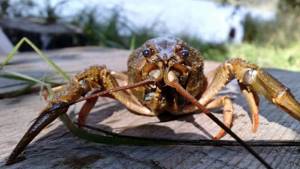
But you can deceive crayfish even easier:
You need to attach a fishing line (strong thread or thin rope) to the end of the fishing rod, it can be an ordinary branch, rod or small stick, and to it a small ring of wire with a diameter of 5-7 centimeters. For a 99 percent result, attach a piece of raw lard to the ring, which has been left in the sun for several days to create a scent.
This device must be cast from a low but steep bank, preferably where there are snags or tree roots. You can attach something like a float for convenience. When the crayfish grabs the ring, you must pull slowly, without jerking, so as not to scare this underwater animal. Place the caught crayfish in a basket with fresh grass and cook at home.
